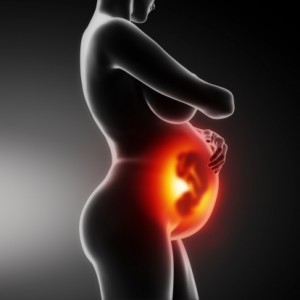Labor Induction May Lower Chances of Shoulder Dystocia
 Babies born with fetal macrosomia and large for gestational age status have an increased risk of experiencing neonatal complications, such as shoulder dystocia and emergency cesarean section.
Babies born with fetal macrosomia and large for gestational age status have an increased risk of experiencing neonatal complications, such as shoulder dystocia and emergency cesarean section.
Prophylactic cesarean delivery and inducing labor prematurely have both been widely thought to prevent complications in delivery and continued fetal growth. However, neither method is recommended for regular use in pregnant women believed to have fetal macrosomia.
Fetal macrosomia occurs when a newborn is significantly larger than average. An infant diagnosed with this condition has a birth weight of more than 8 pounds, 13 ounces, regardless of their gestational age. Only approximately 9% of babies born throughout the world fit into this category.
Labor induction linked to lower risk of shoulder dystocia
A prior Cochrane review of three randomized trials revealed no significant reduction in the risk of shoulder dystocia when labor is induced. However, results may have been limited as most women were at more than 40 weeks gestation. A randomized trial of 822 pregnant women with singleton fetus at a gestational age of 36 to 38 weeks with estimated weight greater than the 95th percentile for gestation age compared labor induction with expectant management. Induction occurred within three days of randomization at gestational a gestational age between 37 weeks and 38 6/7 weeks.
The main outcome was a combination of shoulder dystocia, brachial plexus injury, clavicle or long bone fractures, intracranial hemorrhage or even death. In total, labor was induced in 89% of women randomized to induction, compared with 28% of the expectant management group. When individual outcomes were analyzed, it was discovered that labor induction was linked to a decrease in substantial shoulder dystocia and any shoulder dystocia at all.
Additionally, one general concern with inducing labor is increasing the chances of the mother being forced to have a cesarean section, but in this trial it was actually associated with an increase in spontaneous vaginal delivery. Furthermore, no major differences were observed in regards to neonatal fractures or intracranial hemorrhage, brachial plexus injury or neonatal death.
Shoulder dystocia-related complications & birth injuries
Shoulder dystocia is a case of obstructed labor that occurs after the delivery of the head, when the anterior shoulder of the baby gets stuck or requires significant maneuvering to dislodge. While there are some risk factors that may indicate the imminent presence of this condition, most cases occur without warning. Both the mother and the child can sustain significant injuries if the delivery team does not move quickly and correctly.
Some of the maternal risk factors include gestational diabetes, abnormal pelvic anatomy, previous shoulder dystocia, post-dates pregnancy and short stature. Suspected macrosomia is the main fetal risk factors. Additional delivery room incidents may also increase the likelihood of shoulder dystocia, including protracted active phase of first-stage labor, protracted second-state labor, assisted vaginal delivery by forceps or vacuum.
Maternal complications of this condition may include rectovaginal fistula; postpartum hemorrhage; third-or-fourth-degree episiotomy or tear; symphyseal separation or diathesis — with or without transient femoral neuropathy; and uterine rupture.
Fetal complications may consist of clavicle fracture; brachial plexus palsy; fracture of the humerus; and fetal hypoxia — with or without permanent neurologic damage.
- Clinical Advisor, Fetal Macrosomia and Shoulder Dystocia http://www.clinicaladvisor.com/evidence-based-medicine/fetal-macrosomia-and-shoulder-dystocia/article/442090/
- Mayo Clinic, Fetal Macrosomia http://www.mayoclinic.org/diseases-conditions/fetal-macrosomia/basics/definition/con-20035423
- American Academy of Family Physicians, Shoulder Dystocia http://www.aafp.org/afp/2004/0401/p1707.html


 Resources
Resources
 Resources
Resources
